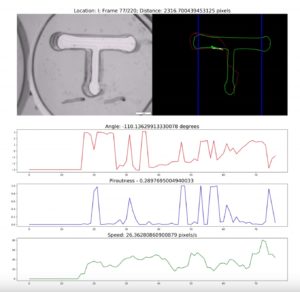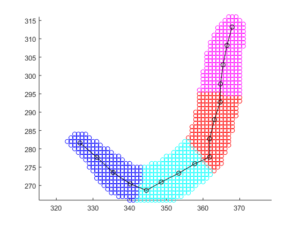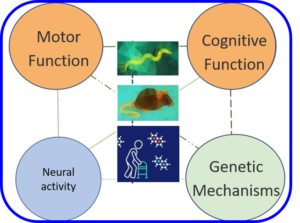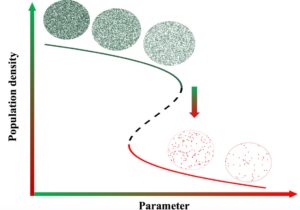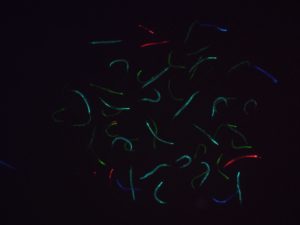Due to the interdisciplinarity of our research, experiments are conducted at both the Mechanical Engineering Dept and the Institute of Gerontology, Medical School. Here you can find a brief description of main projects underway (more about collaborators and students in People, and more about our publications in Publications.)
I am the recipient of a K01 NIH-NIA Career Development Award. I also serve as an Executive Committee member and Associate Director for Space Biology of the newly launched University of Michigan Space Institute.
Spatial navigation, learning, and decision making in C. elegans

This is our main research project, so many of our activities revolve around that. We are exploring C. elegans’ learning and decision making in the structured environment of T-shaped mazes. Using 3D printing technology, we create the WormMaze Platform and we test nematodes’ biased/unbiased decision making and learning, triggered by the presence of food at one maze end. We find that C. elegans are capable of learning in a maze, even in the context of conflicting stimuli. We are currently working on untangling the multisensory mechanism that steers this behavior, and on deciphering the effect of aging.
People involved: Allen Hsu, Kavya Adiga, Anne Goettemoeller, Allison LaMonica, Abrielle Fretz, Lindsay Berardi, Shuangdi Zhang
Related publications: here, and here.
A mathematical framework for C. elegans‘ neuronal circuitry that steers maze behavior
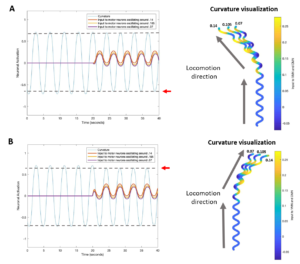
We have developed a mathematical model of C. elegans chemosensory and locomotive circuitry that replicates C. elegans navigation in a T-maze and predicts potential underlying mechanisms that generate maze learning. Based on known neural circuitry, the model circuit responds to food-released chemical cues by modulating motor neuron activity that drives simulated locomotion captures how C. elegans’ chemosensory and proprioceptive circuits interact with the locomotion machinery when worms are making navigation decisions in T-shaped mazes. We aim to use our model to fine tune experiments, generate testable hypotheses, predict neuronal circuit function and decipher worms’ spatial learning mechanism. We are currently working on developing a neuromechanical model that integrates proprioceptive feedback.
People involved: Victoria Booth, Bennet Sakelaris, Michael Ivanitskiy, Zihan Zhou
Related publications: here.
Harnessing 3D printing technology to create C. elegans behavioral arenas
Currently, we are using custom-made behavioral platforms to study how aging and genetic background affects spatial learning and decision making in C. elegans. Thus far we have been creating simple T-shaped mazes that allow us to obtain exciting results. Multilayered, 3-dimensional arenas, however, would be a significantly more insightful means to study navigation and spatial learning. They would also constitute a terrain more similar to nematodes’ natural environment. We are working toward enabling agar bioprinting to create 3-dimensional behavioral arenas for C. elegans nematodes, by customizing an extrusion 3D printer.
People involved: Steel Cardoza, Ray Yang, Noah Brooks
Related publications: here.
Computer vision to decipher C. elegans locomotion in mazes
Significant information is hidden in worms’ locomotion features, as they traverse T-mazes. To understand how the presence of reward (food) on one end of the maze or how learning affects their behavior, we need to go deeper than just he outcome of their decision-making (left/right). Data analytics, computer vision and image processing are used in this effort to analyze video recordings and help us decipher C. elegans behavior in a structured environment, also with regard to the animals’ genetic background, age and physiological status.
People involved: Shurjo Banerjee, Zongyu Li, Jiawei Sun
Related publications: here.
Using control theory and robotics approach to decipher C. elegans gait and locomotive expressions of learning
Much of C. elegans‘ learning is expressed through changes in its locomotion features. The BIRDS lab in UM EECS Department are interested in worms’ locomotion as part of their research regarding bio-inspired robots and the application of biological principles on robotic structures. Recently we joined forces, and we are exploring interdisciplinary ways to understand better the changes in C. elegans locomotion, mainly as a result of environmental feedback and learning.
People involved: Shai Revzen, Maria Schiavone, Brian Bittner, Jakub Kraus
Related publications: in preparation.
Multi-Domain Assessment of Aging-Driven Motor and Cognitive Decline Across Species
We hypothesize that quantitative similarities between aging-driven mobility and cognitive impairments can be revealed at the behavioral, neuronal, and genetic level, across species that are evolutionarily distant, i.e. nematodes and mammals. Through a unified and comprehensive (multi-domain) investigation of selected motor performance indices and cognitive test scores we aim to identify targeted associations across species that can shed light on neurological and evolutionary mechanisms of motor-cognitive interactions that remain obscure. This project is in collaboration with Carlotta Mummolo and the Coppélia Research Lab.
People involved: Carlotta Mummolo, Maria Schiavone, Vincent Zhang, Kubra Akbas
Related publications: in preparation.
Space Biology and Biology of extreme conditions
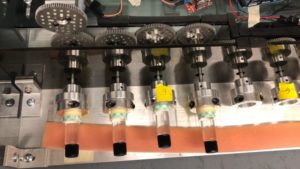 We have recently initiated a new research direction. Using a clinostat (a device that uses rotation to partially negate gravitational forces, see figure) we expose C. elegans nematodes to microgravity. We are exploring the effect of microgravity on nematodes’ morphology, egg laying behavior, locomotion, and response to sensory input. The ultimate goal is to figure out the role of gravity in nematode maze and spatial learning.
We have recently initiated a new research direction. Using a clinostat (a device that uses rotation to partially negate gravitational forces, see figure) we expose C. elegans nematodes to microgravity. We are exploring the effect of microgravity on nematodes’ morphology, egg laying behavior, locomotion, and response to sensory input. The ultimate goal is to figure out the role of gravity in nematode maze and spatial learning.
People involved: Leen Sharba, Cameron Smith, Silas Stewart
Clinostat designed and built by Kevin Wen, Aoqian Zhang, Karthik Bijoy, Yuxuan Ye (ME450, F2021)
Related publications: in preparation.
Past Projects
A custom 3-dimensional imaging system for tracking C. elegans in complex behavioral arenas
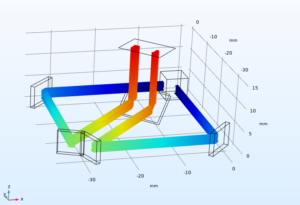
We are working toward building an array of mirrors and lenses that will allow us to image nematodes as they traverse our microscopic 3-dimensional mazes and arenas.
People involved: Srinivasa Cheekati
A 3D microscope rotary base for 3-dimensional specimen observation
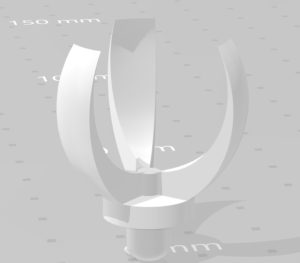
To observe and track C. elegans motion on 3dimensional structures we need to be able to rotate the specimen in all 3 dimensions, by almost 360 degrees. To this end, we built a 3D rotary base that will allow us to do so. We employ CAD and 3D-printing technology.
People involved: Adbul Hasib
Effect of chemically induced oxidative stress on C. elegans sensory neuron function, and behavior
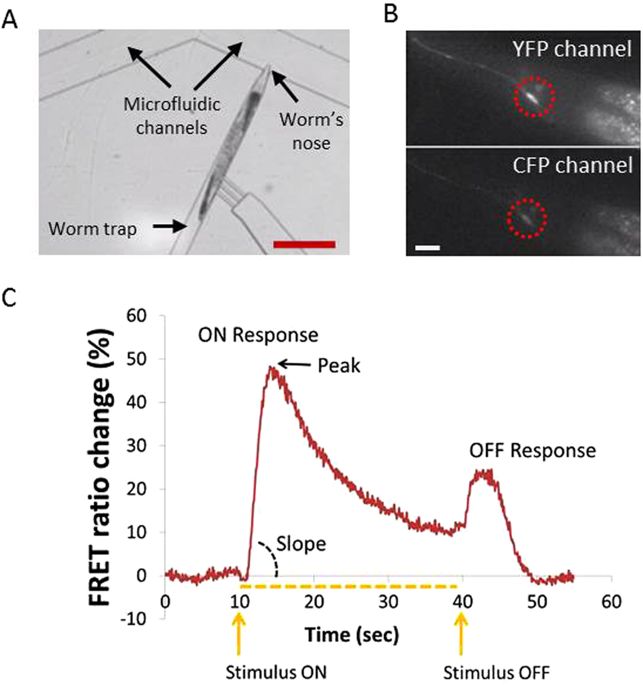
Oxidative stress (OS) impact on a single neuron’s function in vivo remains obscure. Using C. elegans as a model organism, we report the effect of paraquat (PQ)-induced OS on wild type worms on the function of the ASH polymodal neuron. By calcium (Ca2+) imaging, we quantified ASH activation upon stimulus delivery. PQ-treated worms displayed higher maximum depolarization (peak of the Ca2+ transients) compared to untreated animals. PQ had a similar effect on the ASH neuron response time (rising slope of the Ca2+ transients), except in very young worms. OS effect on ASH was partially abolished in vitamin C-treated worms. We performed octanol and osmotic avoidance tests, to investigate the OS effect on ASH-dependent behaviors. PQ-treated worms have enhanced avoidance behavior compared to untreated ones, suggesting that elevated ASH Ca2+ transients result in enhanced ASH-mediated behavior. The above findings suggest a possible hormetic effect of PQ, as a factor inducing mild oxidative stress. We also quantified locomotion parameters (velocity, bending amplitude), which are not mediated by ASH activation. Bending amplitude did not differ significantly between treated and untreated worms; velocity in older adults decreased. The differential effect of OS on behavioral patterns may mirror a selective impact on the organism’s neurons.
People involved: Nikos Chronis
Related publications: here.
Calcium dynamics in C. elegans sensory neurons
Upon stimulation of sensory neurons, intracellular calcium concentration is increased. This is a result of membrane ion channels opening and intracellular calcium stores releasing calcium ions in the cytoplasm. Numerous molecular mechanisms are involved, governing the dynamics of calcium influx and the final return to initial equilibrium upon withdrawal of the stimulus. We have built computational models to capture the intracellular cascades dynamics, considering the biophysics of the system and experimental data generated at my postdoctoral research. There is a gap in the literature regarding reliable models, able to describe and predict calcium dynamics in neurons, varying on different biological conditions (e.g. aging, stress). We have worked towards filling this gap, using C. elegans nematodes as a model system.
People involved: Ehsan Mirzakhalili, Bogdan Epureanu
Related publications: here.
Neuronal networks dynamics
Synaptic deficiencies are known to be a hallmark of neurodegenerative diseases, i.e. Alzheimer’s, but the diagnosis of impaired synapses on the cellular level remains elusive. However, changes in the dynamics of neuronal networks with impaired synapses can be detected by applying smaller resolution. Through our work we investigate how the structure of neuronal networks influences their dynamics when they suffer from synaptic loss. To this end, we simulate different neuronal network structures by specifying their degree distribution. Our findings show a tradeoff between the quality of activity and the persistent activity of networks. We also propose different selection methods to impair synapses in the network, which may correspond to different pathological conditions. Regardless of the network structures, the results demonstrate that synaptic loss has more severe effects on the activity of the network if the impairments are correlated with the activity of the neurons.
People involved: Ehsan Mirzakhalili, Victoria Booth, Bogdan Epureanu
Related publications: here.
Dynamics of C. elegans locomotion under magnetic field
We explore magnetic field effects on locomotion dynamics in the nematode C. elegans. Our work investigates how primary (externally produced by electromagnets) and secondary (internally generated by paramagnetic nanoparticles) magnetic fields dynamically affect motor neuron functionality and locomotion patterns in C. elegans. We have developed a custom-made tracking system for freely moving worms and algorithms to quantify special characteristics of worms’ sinusoidal locomotion (speed, bending frequency, reversals, sharp turns, etc). Change of locomotion parameters due to the impact of magnetic field reveal underlying physiological changes and provide insight on the worms’ ability to sense magnetic field. We combine experimental techniques (bright light, fluorescent and electron microscopy) with computational and modelling approaches. This work aims to understand the dynamics which govern locomotion machinery and excitable cell function.
People involved: Ehsan Mirzakhalili, Yang Zhang, Bogdan Epureanu
Related publications: here.
Rate of recovery from perturbations as a means to forecast future stability of living systems
Anticipating critical transitions in complex ecological and living systems is an important need because it is often difficult to restore a system to its pre-transition state once the transition occurs. Recent studies demonstrate that several indicators based on changes in ecological time series can indicate that the system is approaching an impending transition. An exciting question is, however, whether we can predict more characteristics of the future system stability using measurements taken away from the transition. We address this question by introducing a model-less forecasting method to forecast catastrophic transition of an experimental ecological system. The experiment is based on the dynamics of a yeast population, which is known to exhibit a catastrophic transition as the environment deteriorates. By measuring the system’s response to perturbations prior to transition, we forecast the distance to the upcoming transition, the type of the transition (i.e., catastrophic/non-catastrophic) and the future equilibrium points within a range near the transition. Experimental results suggest a strong potential for practical applicability of this approach for the ecological systems which are at risk of catastrophic transitions, where there is a pressing need for information about upcoming thresholds.
People involved: Amin Ghadami, Bogdan Epureanu
Related publications: here.
Toward labeling C. elegans populations
Tracking individual worms could assist in reducing noise in many standard protocols or behavioral assays. We aspire to fill this gap by using fluorescent nanoparticles to differentially label C. elegans populations. We hypothesize that by applying a unique combination of assorted colored nanoparticles, each worm or subpopulation will have a “fluorescent barcode”. To test our hypothesis, we tag C. elegans with three types of particles, each marked with a different fluorophore. Worm images are analyzed using standard Computer Vision and Image Analysis tools in MatLab. We aim to expand these ideas to identify individual worms.
People involved: Rahul Hingorani, Bo Xue


